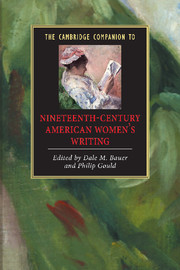Book contents
- Frontmatter
- Introduction
- Part I Historical and theoretical background
- Part 2 Genre, tradition, and innovation
- 4 Captivity and the literary imagination
- 5 Nineteenth-century American women's poetry
- 6 Women at war
- 7 Women, anti-Catholicism, and narrative in nineteenth-century America
- 8 Immigration and assimilation in nineteenth-century US women's writing
- Part 3 Case studies
- Conclusion
- Index
6 - Women at war
from Part 2 - Genre, tradition, and innovation
Published online by Cambridge University Press: 28 May 2006
- Frontmatter
- Introduction
- Part I Historical and theoretical background
- Part 2 Genre, tradition, and innovation
- 4 Captivity and the literary imagination
- 5 Nineteenth-century American women's poetry
- 6 Women at war
- 7 Women, anti-Catholicism, and narrative in nineteenth-century America
- 8 Immigration and assimilation in nineteenth-century US women's writing
- Part 3 Case studies
- Conclusion
- Index
Summary
Recent attention to women's roles in the Civil War has uncovered several stories of women who dressed as men in order to fight in battle, such as Sarah Wakefield on the Union side. The Confederacy had female warriors as well. One Union soldier remembered how “Another She-Devil shot her way to our breastworks with two large revolvers dealing death to all in her path. She was shot several times with no apparent effect. When she ran out of ammunition, she pulled out the largest pig-sticker I ever seen . . . she stabbed three boys and was about to decapitate a fourth when the Lieutenant killed her.” The terrifying specter of such heroism may have affected the difficulty warrior women who survived faced in receiving antebellum pensions. However many cases may eventually be documented, the murderous intentions behind such a rampage were hardly confined to participation in battle. The northerner Gail Hamilton's “A Call to My Country-Women,” for example, complains that “stitching does not . . . hew traitors in pieces before the Lord” (Atlantic Monthly, March 1863, p. 346). And in a response to Hamilton's piece, an anonymous writer for the Loyal Publication Society declared that “many a Southern woman, during this war, has written to husband, brother or lover, to bring home with him 'a dead Yankee, pickled,' or 'a hand, or an ear, or a thumb, at least'” (New York: May 1863). While such extreme manifestations serve as commentary, they also situate the unease of fictional examples. Marion Harland's Sunnybank (1867) has southern women writing to their soldier boyfriends to ask for “rings, and charms, and watch-chains made of the bones of Federal soldiers slain in battle” which might then be “displayed exultingly by Southern ladies as trophies of their lovers' valor” (165).
- Type
- Chapter
- Information
- Publisher: Cambridge University PressPrint publication year: 2001
- 1
- Cited by

